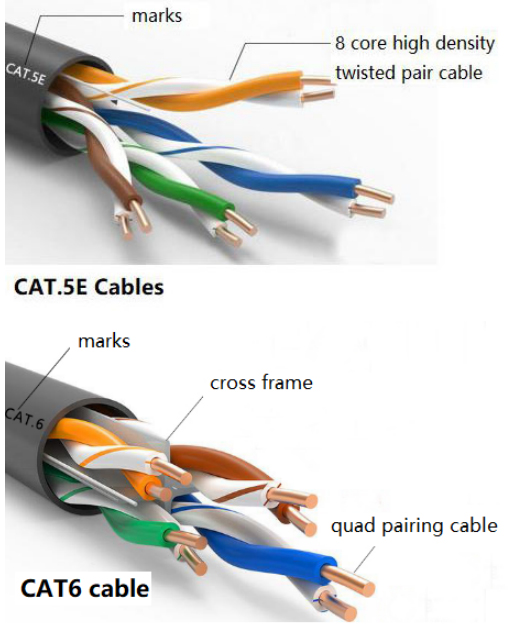News
Column Classification

Release time: 2024-03-17
Nowadays, CAT 5, CAT 5E, CAT 6 and CAT 7 cables are ubiquitous in our lives. While CAT 5 cables have already been replaced by their enhanced version CAT 5E, and CAT 7 cables are rarely used due to high costs. We, as a well established cable manufacturer, is now very delighted to give a brief introduction about the difference among above cables.
|
Type |
CAT 1 |
CAT 2 |
CAT 3 |
CAT 4 |
CAT 5 |
CAT 5E |
CAT 6 |
CAT 6A |
CAT 7 |
|
Function |
As Telephone cables used in the 1980s
|
Applicable to old token networks
|
Mainly used to support 10M Ethernet cables
|
Used for token LAN and Ethernet usage
|
Suitable for 100BASE-T and 10BASE-T networks
|
Suitable for 100BASE-T and 10BASE-T networks
|
Suitable for networks with transmission rates above 1Gbps
|
Mainly used in gigabit networks
|
Adapting to the application of 10 Gigabit Ethernet technology |
|
Transmission Frequency |
low |
1MHZ |
16MHZ |
20MHZ |
100MHZ |
100MHZ |
1-250MHZ |
200-500MHZ |
>500MHZ |
|
Transmission Speed |
low |
4Mbps |
10Mbps |
16Mbps |
100Mbps |
1000Mbps |
1Gbps |
1000Mbps |
10Gbps |
<Network cable types and differences>
Category 5 Cables: 100MHz transmission bandwidth, aimed for data transmission at a speed of 100Mbps and voice transmission. Mainly used for 100BASE-T and 10BASE-T networks and has been replaced by Category 5E cables.
Category 5 enhanced cables: With low attenuation and low crosstalk noise, bandwidth is up to 100MHz. Mainly used for Gigabit Ethernet.
Category 6 cables: transmission speed is far quicker than the last generation, thanks for its 250MHz bandwidth, suitable for the scenarios that requires 1Gbps transmission rate.
Category 6 Augmented Cables: an improved version of CAT 6, mainly used in 10 Gigabit networks. 500MHz transmission frequency with transmission speed up to 10Gbps.
Category 7 cables: it was created to adapt to the rapid development of 10 Gigabit Ethernet technology. It is no longer unshielded, instead, it is shielded twisted pair cable. Thus, boost its transmission frequency > 600 MHz and transmission rate up to 10 Gbps.
That is to say, if we want to build a gigabit network, we need to use at least Category 5 network cables, and using Category 6 cables is more suitable. But when the transmission distance is long ( >100meters), it is necessary to use category 6 or above.
Different cables may have different appearances. Generally speaking, it is difficult to distinguish between Category 5 and Category 5E in terms of appearance, while the difference between Category 5E and Category 6 is quite significant. There is a cross frame inside of Category 6 cables. While
Category 7 are shielded twisted pair cables. In addition to having a shielding layer inside its PVC outer sheath, each pair of wires has a shielding layer too, making it easier to distinguish, cat.5e for Category 5 enhanced cables and cat.6 for Category 6 cables.

Cables are mainly made of pure copper or oxygen-free copper. Oxygen-free copper cables contain up to 99.9% copper, pretty low impurities. The pure copper cables actually are made by bronze, which have a non-negligible higher resistance compared with oxygen-free copper, this is why the majority of CAT5E cables are made of oxygen- free copper, please keep it mind when you purchasing cables.
There is also a difference in thickness between Category 5E and Category 6 cables. The core of Category 5E cables generally ranges from 0.4 to 0.51mm, while Category 6 cables range from 0.52 to 0.6mm. The crystal heads also different among the two categories.
